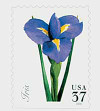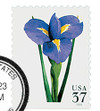
2005 37c Spring Flowers: Iris
# 3903 - 2005 37c Spring Flowers: Iris
$0.35 - $3.20
U.S. #3903
37¢ Iris
Spring Flowers Booklet Stamps
37¢ Iris
Spring Flowers Booklet Stamps
Issue Date: March 15, 2005
City: Chicago, IL
Printing Method: Lithographed
Color: Multicolored
City: Chicago, IL
Printing Method: Lithographed
Color: Multicolored
Three of the plants on the Spring Flowers stamp se-tenant were imported into America. The yellow or yellow-and-orange daffodil is a wild narcissus that came from Europe. The hyacinth, of the lily family, originated in the Mediterranean region and Turkey and was brought to western Europe in the early 1500s. The hyacinth flowers are blue, pink, white, yellow, or purple.
The tulip came from southern Europe and Asia. Variously colored, tulips display one or two hues. The name tulip comes from the Turkish word for turban. Turkish tulips were brought to Europe in the 1500s. Interest in the flower developed into a craze in Holland between 1634 and 1637. Many people lost fortunes investing in tulip bulbs. Finally, the Dutch government was forced to regulate the tulip market.
The iris is native to temperate climates all over the world. Blooming in many shades and combinations of colors, its name comes from the Greek word for rainbow.
Each daffodil, hyacinth, and tulip grows directly out of a bulb, a short, underground stem with a large bud. The iris grows from a rhizome, an underground stem that is usually elongated. In most parts of the United States, bulbs and rhizomes can be left in the ground over the winter to bloom again spring after spring.
U.S. #3903
37¢ Iris
Spring Flowers Booklet Stamps
37¢ Iris
Spring Flowers Booklet Stamps
Issue Date: March 15, 2005
City: Chicago, IL
Printing Method: Lithographed
Color: Multicolored
City: Chicago, IL
Printing Method: Lithographed
Color: Multicolored
Three of the plants on the Spring Flowers stamp se-tenant were imported into America. The yellow or yellow-and-orange daffodil is a wild narcissus that came from Europe. The hyacinth, of the lily family, originated in the Mediterranean region and Turkey and was brought to western Europe in the early 1500s. The hyacinth flowers are blue, pink, white, yellow, or purple.
The tulip came from southern Europe and Asia. Variously colored, tulips display one or two hues. The name tulip comes from the Turkish word for turban. Turkish tulips were brought to Europe in the 1500s. Interest in the flower developed into a craze in Holland between 1634 and 1637. Many people lost fortunes investing in tulip bulbs. Finally, the Dutch government was forced to regulate the tulip market.
The iris is native to temperate climates all over the world. Blooming in many shades and combinations of colors, its name comes from the Greek word for rainbow.
Each daffodil, hyacinth, and tulip grows directly out of a bulb, a short, underground stem with a large bud. The iris grows from a rhizome, an underground stem that is usually elongated. In most parts of the United States, bulbs and rhizomes can be left in the ground over the winter to bloom again spring after spring.











